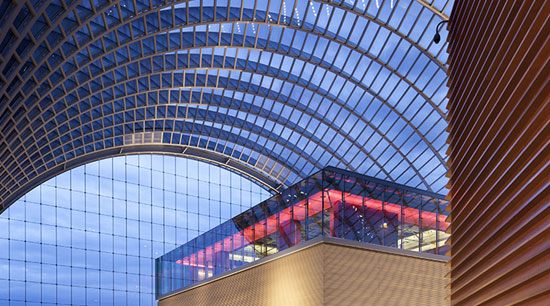Dynamic Solar Control with Electrochromic Glazing
• Quality Control: Since EC glazing is typically made into insulated glazing units (IGUs), ASTM E2190 standard for IGU performance is a minimal quality standard. After that, ASTM 2141-06 Standard for electrochromic coatings on IGUs is an obvious requirement as well. In addition, specifying products that come from manufacturers that carry IGMA & IGCC certifications will be worthwhile.
• Submittals: Some submittals can be requested during the design review stage of a project or they can be reviewed during construction. Common submittals might include:
• Modeling of glass performance
• Glazing design, zoning layout and control documentation
• Technical coordination for control system and wiring
• On-site mock-ups
• Coordination – The EC glazing will require low voltage electrical input and control connections, therefore the work of the EC glazing section will need to be coordinated with the work of those sections and vice versa.
• Products: As with all glazing, there are options and choices among manufactured products. Perhaps the most significant will be the choice of double- or triple-pane insulated EC glazing since that will affect frame sizes and detailing in addition to energy performance. It is also possible to use various shapes and sizes of EC glazing. Essentially any rectilinear or triangular shape is possible; however, circles and arcs are not currently available. Finally, just like other glazing, there are choices in glass and tint colors including grays, blues, and greens. This allows ready coordination with other glass tint colors in the building that may not be electrochromic.
• Installation: Using an experienced installer is important for proper installation of the EC glazing and control system. It is also possible to request that the EC glazing be part of a building envelope commissioning process.
• Maintenance: On-site support for training building management staff is important so that it is programmed and used as intended. Otherwise, maintenance and cleaning will be the same as other insulated glass units.
| Case Study: Kimmel Center for the Performing Arts | ||
PROJECT: Hamilton Garden Terrace at the Kimmel Center, Philadelphia, Pennsylvania The Challenge The Solution At the Kimmel Center, the EC glazing helped transform the Hamilton Garden Terrace into an elegant glass and steel structure that does not have the original space’s noise and temperature problems. A new glass enclosure limits event sound propagation, and a 2,100-square-foot rooftop made from EC glazing lets the building’s owners maintain a comfortable temperature for occupants without obstructing the space’s breathtaking views of the city. Benefits
Architect Lisle added that the EC Glazing helped her firm deliver a “wow factor” that the building owner very much wanted in the new design. “When the EC skylights fully tint, they create this big defined square of clear cobalt blue that is stunning to view from the plaza below or outside from the street,” Lisle said. “The building owner also wanted the design to enhance the rental appeal of the terrace as a ‘sky room’ which was characterized by its connection to the day and night sky and the unique perspective of seeing the cityscape from above. Being able to maintain those views with EC glass helped us achieve those objectives.” |
Conclusion
Dynamically controllable electrochromic glazing has emerged as a real and viable option for buildings of all types particularly those seeking to be sustainable. Properly used and designed into buildings, it has been shown to significantly improve building energy performance and reduce peak electrical demand, while also reducing emissions. It also enhances the human experience in buildings by maintaining views and enhancing daylight while controlling solar heat gain and glare. Overall, it allows windows and the buildings that they are located in to interact directly by responding to both the exterior conditions and the needs of the occupants. This 21st Century technology will likely benefit designers, building owners, and building occupants for years to come.
 |
SageGlass®, a product of Saint-Gobain, is advanced dynamic glass that can be electronically tinted or cleared to optimize daylight and improve the human experience in buildings. With SageGlass you can control sunlight and glare without shades or blinds while maintaining the view and connection to the outdoors. SageGlass is manufactured in Faribault, MN, in the heart of the “Silicon Valley of the window industry,” and is a wholly owned subsidiary of Saint-Gobain of Paris, the world's largest building materials company. www.sageglass.com |









